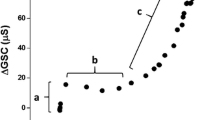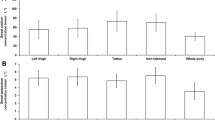Abstract
Purpose
Changes in mean skin temperature (Tsk) have been shown to modify the maximum rate of sweat ion reabsorption. This study aims to extend this knowledge by investigating if modifications could also be caused by local Tsk.
Methods
The influence of local Tsk on the sweat gland maximum ion reabsorption rates was investigated in ten healthy volunteers (three female and seven male; 20.8 ± 1.2 years, 60.4 ± 7.7 kg, 169.4 ± 10.4 cm) during passive heating (water-perfused suit and lower leg water immersion). In two separate trials, in a randomized order, one forearm was always manipulated to 33 °C (Neutral), whilst the other was manipulated to either 30 °C (Cool) or 36 °C (Warm) using water-perfused patches. Oesophageal temperature (Tes), forearm Tsk, sweat rate (SR), galvanic skin conductance (GSC) and salivary aldosterone concentrations were measured. The sweat gland maximum ion reabsorption rates were identified using the ∆SR threshold for an increasing ∆GSC.
Results
Thermal [Tes and body temperature (Tb)] and non-thermal responses (aldosterone) were similar across all conditions (p > 0.05). A temperature-dependent response for the sweat gland maximum ion reabsorption rates was evident between 30 °C (0.18 ± 0.10 mg/cm2/min) and 36 °C (0.28 ± 0.14 mg/cm2/min, d = 0.88, p < 0.05), but not for 33 °C (0.22 ± 0.12 mg/cm2/min), d = 0.44 and d = 0.36, p > 0.05.
Conclusion
The data indicate that small variations in local Tsk may not affect the sweat gland maximum ion reabsorption rates but when the local Tsk increases by > 6 °C, ion reabsorption rates also increase.




Similar content being viewed by others
Abbreviations
- ANOVA:
-
Analysis of variance
- CFTR:
-
Cystic fibrosis transmembrane channels
- Cl− :
-
Chloride
- CVC:
-
Cutaneous vascular conductance (%)
- ENaC:
-
Epithelial sodium channel
- GSC:
-
Galvanic skin conductance (µS)
- HASG:
-
Heat-activated sweat glands
- HR:
-
Heart rate (bpm)
- K+ :
-
Potassium
- MAP:
-
Mean arterial pressure (mmHG)
- Na+ :
-
Sodium
- SGO:
-
Sweat gland output
- SR:
-
Sweat rate (mg/cm2/min)
- T b :
-
Body temperature (°C)
- T es :
-
Oesophageal temperature (°C)
- T sk :
-
Skin temperature (°C)
- O2max :
-
Maximum oxygen uptake (ml/kg/min)
References
Amano T, Gerrett N, Inoue Y et al (2016) Determination of the maximum rate of eccrine sweat glands’ ion reabsorption using the galvanic skin conductance to local sweat rate relationship. Eur J Appl Physiol 116:281–290
Amano T, Hirose M, Konishi K et al (2017) Maximum rate of sweat ions reabsorption during exercise with regional differences, sex, and exercise training. Eur J Appl Physiol. https://doi.org/10.1007/s00421-017-3619-8
Bovell D (2015) The human eccrine sweat gland: structure, function and disorders. J Local Glob Heal Sci 2015:5. https://doi.org/10.5339/jlghs.2015.5
Bulmer MG, Forwell GD (1956) The concentration of sodium in thermal sweat. J Physiol 32:5–122
Buono MJ, Jechort A, Marques R et al (2007) Comparison of infrared versus contact thermometry for measuring skin temperature during exercise in the heat. Physiol Meas 28:855–859. https://doi.org/10.1088/0967-3334/28/8/008
Buono MJ, Claros R, Deboer T, Wong J (2008) Na+ secretion rate increases proportionally more than the Na+ reabsorption rate with increases in sweat rate. J Appl Physiol 105:1044–1048. https://doi.org/10.1152/japplphysiol.90503.2008
Buono MJ, Tabor B, White A (2011) Localized β-adrenergic receptor blockade does not affect sweating during exercise. Am J Physiol Integr Comp Physiol 300:R1148–R1151. https://doi.org/10.1152/ajpregu.00228.2010
Chraïbi A, Horisberger J-D (2003) Dual effect of temperature on the human epithelial Na+ channel. Pflug Arch Eur J Physiol 447:316–320. https://doi.org/10.1007/s00424-003-1178-9
Cohen J (1977) Statistical power analysis for the behavioral sciences. Lawrence Erlbaum Associates, Hillsdale
Convertino V, Keil LC, Greenleaf JE (1983) Plasma volume, renin, and vasopressin responses to graded exercise after training. J Appl Physiol 54:508–514
Darrow CW (1964) The rationale for treating the change in galvanic skin response as a change in conductance. Psychophysiology 1:31–38
Freund BJ, Shizuru EM, Hashiro GM et al (1991) Hormonal, electrolyte, and renal responses to exercise are intensity dependent. J Appl Physiol 70:900–906
Gagge AP, Nishi Y (2011) Heat exchange between human skin surface and thermal environment. In: Comprehensive physiology. Wiley, Hoboken, pp 69–92
Gao W, Brooks GA, Klonoff DC (2018) Wearable physiological systems and technologies for metabolic monitoring. J Appl Physiol 1:548–556
Gerrett N, Amano T, Inoue Y et al (2018a) The effects of exercise and passive heating on the sweat glands ion reabsorption rates. Physiol Rep. https://doi.org/10.14814/phy2.13619
Gerrett NM, Griggs KE, Redortier B et al (2018b) Sweat-from gland to skin surface—production, transport and skin absorption. J Appl Physiol. https://doi.org/10.1152/japplphysiol.00872.2017
Harvey BJ, Higgins M (2000) Nongenomic effects of aldosterone on Ca2+ in M-1 cortical collecting duct cells. Kidney Int 57:1395–1403. https://doi.org/10.1046/j.1523-1755.2000.00981.x
Hegarty J, Harvey BJ (1998) Aldosterone increases intracellular calcium in cultured human sweat gland epithelial cells by a non-genomic mechanism of action. J Physiol 511:36P
Hew-Butler T, Noakes TD, Soldin SJ, Verbalis JG (2010) Acute changes in arginine vasopressin, sweat, urine and serum sodium concentrations in exercising humans: does a coordinated homeostatic relationship exist? Br J Sports Med 44:1710–1715. https://doi.org/10.1136/bjsm.2008.051771
Hew-Butler T, Hummel J, Rider BC, Verbalis JG (2014) Characterization of the effects of the vasopressin V2 receptor on sweating, fluid balance, and performance during exercise. Am J Physiol Regul Integr Comp Physiol 307:R366–R375. https://doi.org/10.1152/ajpregu.00120.2014
Inoue Y (1996) Longitudinal effects of age on heat-activated sweat gland density and output in healthy active older men. Eur J Appl Physiol Occup Physiol 74:72–77. https://doi.org/10.1007/BF00376497
Inoue Y, Nakao M, Ishizashi H et al (1998) Regional differences in the Na+ reabsorption of sweat glands. Appl Hum Sci 17:219–221
Johnson RE, Pitts GC, Consolazio FC (1944) Factors influencing chloride concentration in human sweat. Am J Physiol 141:575–589. https://doi.org/10.1152/ajplegacy.1944.141.4.575
Kenefick RW, Cheuvront SN, Elliott LD et al (2012) Biological and analytical variation of the human sweating response: implications for study design and analysis. Am J Physiol Regul Integr Comp Physiol 302:252–258. https://doi.org/10.1152/ajpregu.00456.2011
Kirby CR, Convertino VA (1986) Plasma aldosterone and sweat sodium concentrations after exercise and heat acclimation. J Appl Physiol 61:967–970
Machado-Moreira CA, Edkins E, Iabushita AS et al (2009) Sweat gland recruitment following thermal and psychological stimuli. In: Castellini JW (ed) 13th international conference of environmental ergonomics, Boston, MA, USA
Mekjavic IB, Rempel ME (1990) Determination of esophageal probe insertion length based on standing and sitting height. J Appl Physiol 69:376–379. https://doi.org/10.1152/jappl.1990.69.1.376
Nadel ER, Bullard RW, Stolwijk JA (1971) Importance of skin temperature in the regulation of sweating. J Appl Physiol 31:80–87
Reddy M, Quinton P (2003) Functional interaction of CFTR and ENaC in sweat glands. Pflüg Arch Eur J Physiol 445:499–503. https://doi.org/10.1007/s00424-002-0959-x
Robinson S, Gerking SD, Tuerell ES, Kincaid RK (1985) Effects of skin temperature of salt concentration of sweat. J Appl Physiol 2:654–662
Ruff RL (1999) Effects of temperature on slow and fast inactivation of rat skeletal muscle Na(+) channels. Am J Physiol 277:C937–C947
Sato K (1977) The physiology, pharmacology, and biochemistry of the eccrine sweat gland. Springer, Berlin, pp 51–131
Shamsuddin AKM, Kuwahara T, Oue A et al (2005a) Effect of skin temperature on the ion reabsorption capacity of sweat glands during exercise in humans. Eur J Appl Physiol 94:442–447. https://doi.org/10.1007/s00421-005-1354-z
Shamsuddin AKM, Yanagimoto S, Kuwahara T et al (2005b) Changes in the index of sweat ion concentration with increasing sweat during passive heat stress in humans. Eur J Appl Physiol 94:292–297. https://doi.org/10.1007/s00421-005-1314-7
Smith CJ, Havenith G (2012) Body mapping of sweating patterns in athletes: a sex comparison. Med Sci Sports Exerc 44:2350–2361. https://doi.org/10.1249/MSS.0b013e318267b0c4
Stolwijk JA, Hardy JD (1966) Partitional calorimetric studies of responses of man to thermal transients. J Appl Physiol 21:967–977
Thomas PE, Korr IM (1957) Relationship between sweat gland activity and electrical resistance of the skin. J Appl Physiol 10:505–510
Yoshida T, Shin-ya H, Nakai S et al (2006) Genomic and non-genomic effects of aldosterone on the individual variation of the sweat Na+ concentration during exercise in trained athletes. Eur J Appl Physiol 98:466–471. https://doi.org/10.1007/s00421-006-0295-5
Acknowledgements
We thank our participants for volunteering their time. We also thank Drs S. Koga and D. Okushima for their insightful comments during the preparation of this manuscript. Finally, we thank Dr Koji Sato for his assistance with aldosterone analysis. This study was supported by a Grant-in-Aid for Scientific Research (16H04851 and 17H0253) from the Japan Society for the Promotion of Science from the Ministry of Education, Culture, Sports, Science, and Technology of Japan.
Author information
Authors and Affiliations
Contributions
Nicola Gerrett, Tatsuro Amano and Narihiko Kondo conceived and designed the research. Nicola Gerrett conducted all experiments and analysed the data. All authors were involved in the interpretation of the data. Nicola Gerrett drafted the manuscript and all authors read, edited and approved the manuscript.
Corresponding author
Ethics declarations
Conflict of interest
The authors declare no conflicts of interest, financial or otherwise.
Additional information
Communicated by Guido Ferretti.
Publisher’s Note
Springer Nature remains neutral with regard to jurisdictional claims in published maps and institutional affiliations.
Rights and permissions
About this article
Cite this article
Gerrett, N., Amano, T., Havenith, G. et al. The influence of local skin temperature on the sweat glands maximum ion reabsorption rate. Eur J Appl Physiol 119, 685–695 (2019). https://doi.org/10.1007/s00421-018-04059-5
Received:
Accepted:
Published:
Issue Date:
DOI: https://doi.org/10.1007/s00421-018-04059-5




